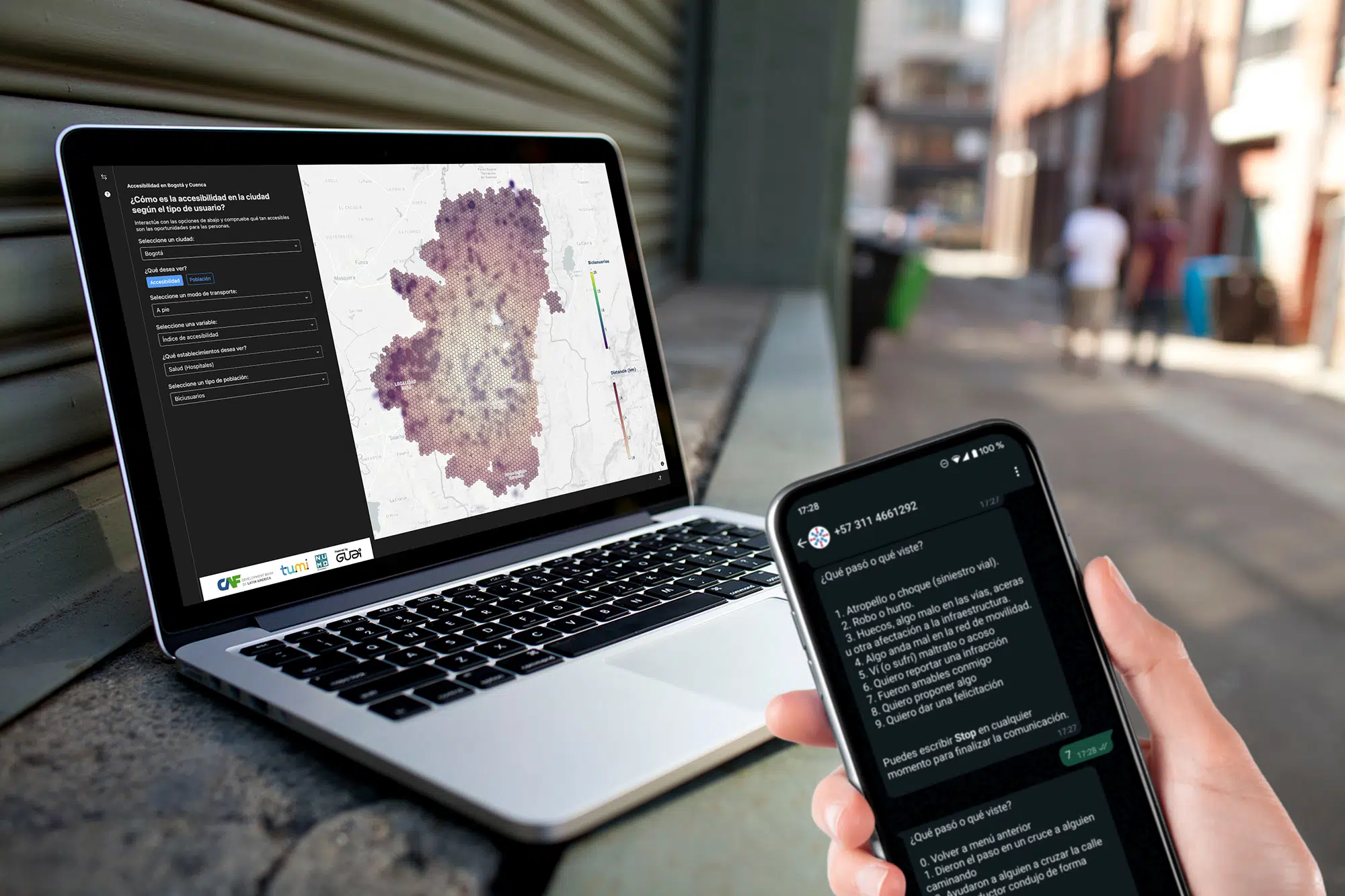Data collection and analysis are key to sustainable, accessible, smart, and reliable mobility. Without up-to-date data on travel patterns and existing transport infrastructure, city leaders cannot make efficient planning decisions. However, for data in mobility to reach its full potential, it is not enough to only collect and analyze data. What we need is good data governance. Efforts are being made to establish data infrastructures to ensure better access, interoperability, and usability of mobility data. Read on to learn more about how data hubs can unlock the potential of data for sustainable mobility planning and implementation, and how the Transformative Urban Mobility Initiative (TUMI) is contributing to these efforts.

© TUMI
Why Mobility and Data must work together
Cities are responsible for nearly 70% of global emissions and 75% of global resource consumption. At the same time, they are threatened by the effects of climate change. In addition, many cities face the challenge of planning for a rapidly growing population, which in turn creates more traffic. Promoting sustainable mobility is therefore a high priority for many countries and cities. Planning decisions made in the next decade will determine urban infrastructure and living conditions for the next 200 years.
Given that transport is a major contributor to global greenhouse gas emissions (currently around ¼, rising to 80% in the near future if we do not act), it is particularly important to work towards more sustainable urban mobility. But to achieve this, we need evidence-based and well-considered decisions based on the best possible information. People-centered, integrated planning for compact, dense, and polycentric cities and 15-minute cities is the way forward, enabling accessibility, social inclusion and cleaner air in cities while reducing emissions. By improving public transport systems, promoting, and planning for active mobility, and integrating energy-efficient, clean transport modes such as e-mobility, cities will become more livable.
How Data and Mobility can work together
The use of data in transport is diverse. This covers everything from service operation to demand-driven offers, to predicting future passenger loads and monitoring services. Most importantly, public administrations use data for urban and mobility planning. As a sector we are tapping into new data sources that enable new types of analyses. Mobile phones produce data about the locations and movements of individuals, and remote sensing has also proven to be a beneficial source for generating insights into changes of physical transport infrastructure. In order to handle large datasets, Artificial Intelligence (AI) holds promising potential, as it can identify patterns in large data sets. However, even the most innovative tools cannot reach their full potentials when bad practices in data governance are in place.
Data needs to be managed well
To maximize the benefits of mobility data, data governance practices need to be addressed: Often, data is collected in silos, not used to its full potential, or only accessible to specific stakeholders, departments, or agencies – even within the same city. This can inhibit collaboration and innovation. Given that data has become a critical component of government operations and decision-making processes, good governance is even more important to further promote economic development, resource management and environmental protection.
The most common problems originating from bad data governance concern:
- Availability: Data is inaccessible and locked away.
- Usability: Data is difficult to process due to a lack of structure.
- Standardization: Differences in data formats make it difficult to integrate datasets.
- Documentation: Datasets often lack proper documentation.
- Updates and maintenance: Regular updates and maintenance of datasets are neglected.
This can lead to duplication of data sets and data collection efforts, inefficient use of resources, and missed opportunities for collaboration. Despite the widespread use of spatial data and GIS, access is often hampered by factors such as institutional barriers, technical limitations, and cultural attitudes.
As a result, decision-makers can only access, apply and use a limited percentage of the data available.

© TUMI
The case for data hubs
A data hub is a centralized repository that allows cities to efficiently collect, organize and share data. Many cities around the world have created data hubs to help gain real-time insights, standardize data, promote interoperability, and ensure easy accessibility.
Importantly, for a data hub to work efficiently, a city needs good quality data. It also needs to develop the technical capacity to operate the hub and make effective use of the data. Operating the necessary infrastructure can be daunting and, in some cases, costly. However, by using open data and open code, these costs can be drastically reduced.
TUMI’s contribution to setting up data hubs
The Transformative Urban Mobility Initiative (TUMI) supports cities to overcome their data governance challenges for sustainable mobility. Our aim is to provide the infrastructure and technical capacity required for data hubs, allowing cities to focus on improving data collection and analysis. TUMI has created a Mobility Data Hub to efficiently collect, organize, and distribute data. The Hub includes data from cities around the world, consolidating dispersed urban mobility data from over 2,000 resources.
The TUMI Mobility Data Hub operates as an integrated ecosystem composed of four main components:
- The Core Software: Built on the open-source software CKAN, the go-to solution for open data portals, the TUMI Mobility Data Hub guarantees compatibility with data portals from around the world.
- Open-Source Software as a Service (SaaS): Cities or governmental organizations up to a regional or national level lacking a data hub can establish one with TUMI‘s support. Each city can have their unique own integrated instance within the data hub, allowing for direct data uploads and even autonomous management. When a city is ready to fully integrate the hub, the instance can be smoothly transferred to their own servers.
- Centralized Repository for Mobility Data: TUMI’s Data Hub consolidates urban mobility data from over 2,000 resources on individual instances, turning dispersed city hubs into a single, searchable mobility data catalogue.
- Adaptable and Replicable Data Applications: TUMI is developing a range of applications that harness data from the hub through standardized interfaces. This allows the data to be processed, analyzed and visualized for specific use cases.
Good data management is the basis for data-driven analyzes in the mobility sector. And we will certainly see this becoming increasingly important in the future. At TUMI we believe that data hubs are an immense support for harnessing the potential of mobility data.